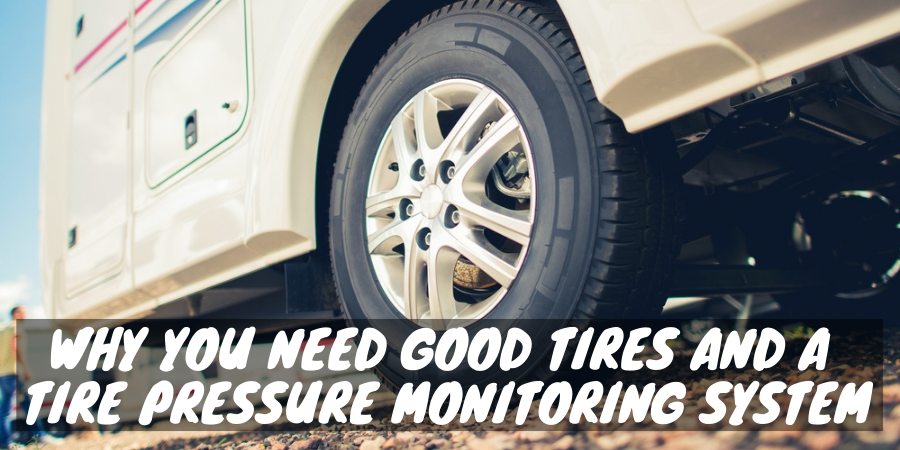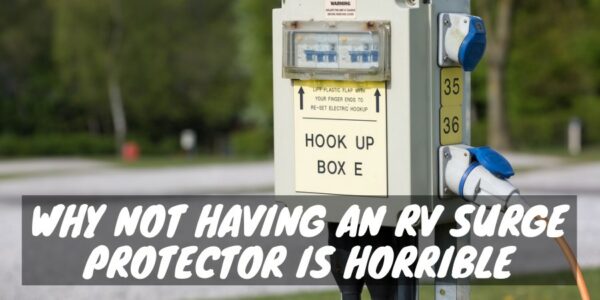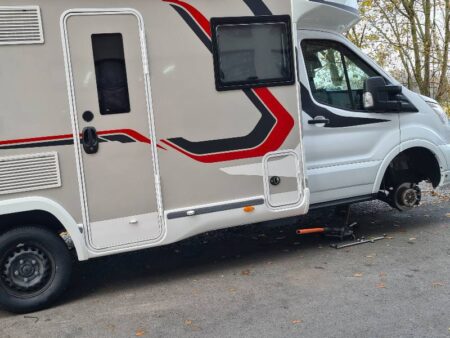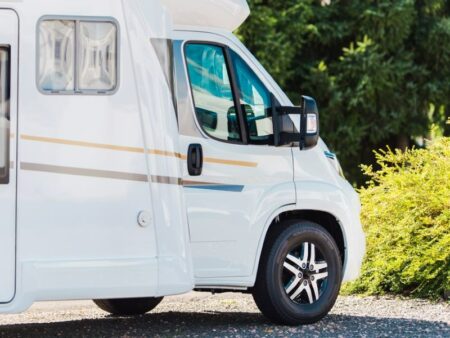RV tires are expensive. So, too, are repairs to your RV caused by tire blowouts.
Trying to drive a large recreational vehicle is difficult in the best of circumstances. When you add in the sudden loss of control a blown tire causes, it can quickly lead to crashes or severe undercarriage damage.
The best way to keep your RV adventures on track is to invest in quality tires and the best tire pressure monitoring system (TPMS) you can afford, so you detect potential issues before they happen.
Novice RVers may not know the importance of appropriate RV tires and TPMS systems, or others may put off purchasing due to the cost.
To help you understand why good RV tires and TPMS kits are a must-have, keep reading!
RV Tire Importance
Unlike a car, RVs put extreme stress on tires from the overall weight, plus the extra pressure when the camper sways or rocks from the wind while going down the road.
RV tires need to be of high quality mainly because most RVers routinely overpack their camper, adding unsafe weight to the camper’s chassis and axles and the tires.
RVers rarely take the time to read load specifications in their manual or bring the RV to a weigh station to get before-packing and after-packing weight information so they can travel within safe limitations.
Even worse, campers who overpack often do so unevenly within the RV, so there is more strain on one or more tires.
Many RVers also don’t check tire age or know where to find it since RV tires need replacement every five years at maximum.
Storage through harsh winters and exposure to UV rays throughout the camping season deteriorates tire strength.
These common scenarios cause uneven wear and tear on RV tires that can lead quickly to blowouts once you hit the road.
Benefits of Good RV Tires
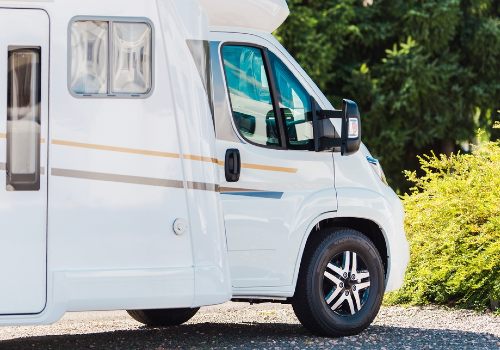
Quality tires significantly enhance your RV driving experience, offering improvements in the following areas:
- Handling during turns or lane changes
- Better braking distances
- Lower fuel expenditure
Durable RV tires are commercial-grade and made for the abuse put upon them by excessive weight and miles of road travel.
Heavy-duty truck tires are expensive, often in the $200+ range apiece, but necessary to safely get you to and from your travel destinations.
RV tires handle best when you ensure you distribute the load evenly, but they also need to withstand the all-to-common weight imbalance RVers unwittingly produce.
How to Check RV Tire Age
Even new RVs fresh from the lot can have tires manufactured a year or two previous. Even if there are few real miles on them, deterioration begins as soon as they come from the factory.
To ensure you’re getting safe tires on any RV, first look at the tire tread and sidewalls. Any unevenness in the tread or bulges or cracking in the sidewall rubber indicates age or damage. Replace the tires if you spot these issues, no matter how old the tire is.
Second, find the date on your RV tires. Check out each tire sidewall and write down the last four numbers in the group directly after the letters “DOT.” There could be upwards of 12 digits after the DOT, but since 2000, it’s the last four that tell you the manufacture date.
All tire manufacturers must emboss the date weekly into tires during production. Always check all your tires, and do not assume they’e from the same batch or installed at the same time.
The first two numerals indicate the week of the year. For example, if the number is 02, it was made in mid-January. If the number is 52, it came off the line in late December.
The second two numbers identify the year. For example, tires from 2018 will have the last two digits of 18.
TIP: Replacing tires on a used motorhome can cost around $1500, so knowing the RV tire age can help you negotiate a better price if they need replacement.
What to Look For in Quality RV Tires

It’s amazing all the nifty new things you get to learn when you become an RV owner. Tires are no exception, and here are the features you need to look for:
Size
There is no singular tire size for all RVs, and choosing the wrong size is a safety hazard. Never skimp on size to save money.
Open the owner’s manual or look up the brand of RV you own online. Find the tire size the manufacturer recommends for the RV weight and design, as this is the safest minimum size you should install.
Load Range/Sidewall Strength
Many people overlook the importance of load range (also called sidewall strength) for RV tires.
Since so many RVers overload their camper with supplies, the extra weight puts undue pressure on tire sidewalls. Having a more robust tire can offset this issue.
Many RV manuals don’t include specs for sidewall load ratings, which can leave you wondering.
Remember that truck tires offer better sidewall strength over heavy-duty car tires, and opting for a healthy load rating is best for RVs.
Weight Rating
Statistics from the Recreation Vehicle Safety Education Foundation indicate that around 50% of RVs on the road exceed weight ratings!
Tire blowouts are an accident just waiting to happen, so make sure you aren’t one of the victims.
Your RV’s GCWR or Gross Vehicle Weight is what the manufacturer expects the actual weight of the RV to be when fully loaded.
Your RV tires need to meet or exceed this weight rating as people overload their RVs all the time.
Road Conditions
Where you travel in your RV is another essential factor when selecting tires.
All-purpose treads are sufficient for most RVers, but you may camp in locations that require something that provides more safety.
Consider snow tires if you camp off-grid and need tires with better traction.
Look for a tire tread specific for efficient water dispersal if you travel where it rains often.
Best RV Tire Option
When shopping for RV tires, look for “all-position, commercial truck tires,” which is vital no matter what brand you choose.
Do not select “commercial trailer tires”, even if you have a travel trailer, as these are for semi-tractor trailers and not RVs.
Only all-position commercial truck tires can handle the demands of driving and controlling an RV with the durability and strength you need.
The Importance of an RV Tire Pressure Monitoring System
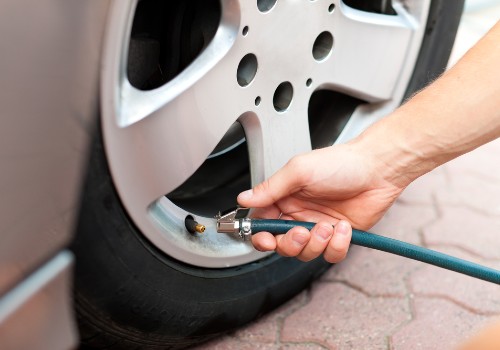
The purpose of an RV tire pressure monitor is:
- To prevent wear and damage to tires from improper inflation
- To reduce the chance of blowouts by getting real-time alerts when dangerous tire conditions arise
- Improve handling
- Increase fuel efficiency
Knowing you have a tire losing air pressure or internal heat reaching a critical level allows you to pull over and fix the tire before a dangerous blowout occurs.
Not all RV TPMS are alike, so let’s break down the different options and features to look for so you can find the right system for your needs.
RV Tire Pressure Monitoring System Options
There are two options for RV Tire Pressure Monitoring Systems, with the details of each below.
Direct RV Tire Monitoring System
The better of the two types of TPMS systems for RVs is the direct version, where a sensor gets installed inside each of your travel trailer, fifth-wheel, or motorhome tires.
Some direct systems can attach to existing tire stem valves and run off a battery-powered sensor.
The system is wireless, with each tire sensor having a different code. When a problem arises, you receive the alarm quickly, but the unique code tells you exactly which tire is the problem.
The direct system is better because it monitors pressure and other concerns, such as temperature, and continually sends that information to the control module, where a computer filters the data.
A screen on your RV or tow-vehicle dash displays the data as it refreshes, and an alarm will sound if it detects critical problems. Many TPMS kits can transmit data to an app on a tablet or smartphone.
You will pay more for a direct RV tire pressure monitoring system because the components and installation are more expensive.
For avid RVers, having a fast, accurate, and reliable system is a must, as it alleviates that nagging worry you have about your RV tires as you’re driving at highway speeds or over rough roads.
Indirect RV Tire Monitoring System
Indirect RV tire pressure monitors work with existing tire sensors that are there to track rotational speed. For the occasional camper, these systems work well.
Without special sensors, indirect TPMS only works for changes in tire pressure large enough to trigger an alert to the driver.
Want to Connect With a Community of Over 1,078 RV Enthusiasts?
Indirect TPMS is a very affordable and relatively easy DIY install. The trade-off is less accuracy and tire details that you may need to feel confident driving your RV on long road trips.
Important TPMS Features
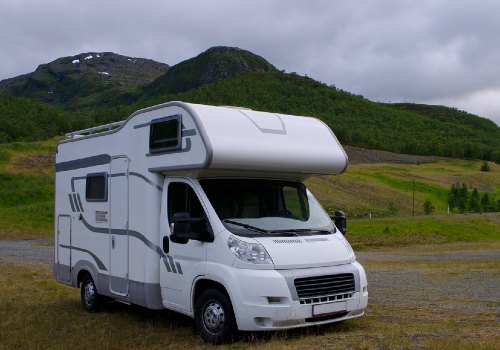
Different brands or models of RV tire pressure monitor systems have features that range from basic to technologically advanced.
Depending on your RV type, the distance you travel, the cost of replacement tires, and other factors determine which features you require and which ones are a convenient bonus.
Easy To Read Display
RV and truck dashboards can be expansive, so placing your TPMS display means that it may be further away than your normal range of vision.
A large display with a large font, non-glare glass, sound, and colors helps you read all the tire information on the screen without strain or guesswork. An audible alarm adds to the value.
The best monitor sending you the best information is useless if you can’t read it while on the road in your recreational vehicle.
Data Displayed
The whole point of a TPMS is to keep track of your RV tire pressure and warnings, whether you have two tires or six.
Find a system that can handle the number of tires on your RV without glitching or cycling so slowly that you can’t get a feel for what is going on while driving.
The most critical data will, of course, be the tire pressure that will monitor over and under-inflation.
Tire temperature and acceleration are other data that top the features list. Alerts can allow you to stop and give your tires a break when pushed to the limit.
Excessive tire temperate splits the tire ply, which delaminates at high speeds and causes a blowout or flat.
Durability
RV-specific TPMS should be built tough, with components that won’t vibrate loose or fall off during travel.
If your monitoring system breaks, whether it’s the display, the control box, or the sensors, you will not have the tire information that keeps you, your occupants, and your recreational vehicle safe.
Battery Quality
Batteries are a critical element of TPMS as sensors rely on them to transmit the data they collect.
Batteries should be tightly sealed against the elements to prevent corrosion and have a long life for fewer replacement hassles.
Installation
Professional installation of a direct RV TPMS by a certified mechanic skilled in this system is a suggestion from users. The results and performance will be better, and you can have the work warranted against failure.
If you have confidence in your mechanical or handyperson skills, there are systems you can install yourself. Pairing the sensors to the monitor may take more time than sensor installation, but all the steps are relatively straightforward.
Top TPMS Systems for RVs
If the budget isn’t a concern, consider the EEZTire-TPMS6 Tire Pressure Monitoring System for your RV.
The lithium batteries are rechargeable, and the controller quickly transmits data, so there is no lag time between tire issues and both audio and visual alerts to your display.
Users rave about the reliability, which makes it worth the investment.
For a DIY tool-free install, take a look at the Bellacorp Tire Pressure Monitoring System. The price is more affordable, and customers mention the long-lasting sensors, quick updates, and backlit display as the best features.
Final Thoughts
Getting to your destination in an RV is half the fun! Being stuck on the side of the road because you lost a tire is not the type of memory you want to make.
Stop risking your family and others’ safety on the road and avoid costly damage to your RV by investing in the best RV tires and equipment.
I hope you use the information above to start all your RV journeys with the sense of security a quality set of tires and tire pressure monitoring system can provide. When you do, you can enjoy safer travels for years to come!
RV and Truck Tire Safety | Best TPMS (Tire Pressure Monitoring System) (Video)
"Man cannot discover new oceans unless he has the courage to lose sight of the shore."
-- Andre Gide

